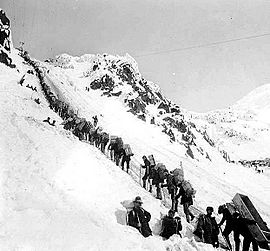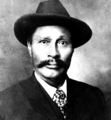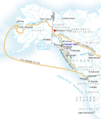Klondike Gold Rush facts for kids
Quick facts for kids Klondike Gold Rush |
|
|---|---|

Prospectors ascending the Chilkoot Pass, 1898
|
|
| Other names | Alaska Gold Rush, Yukon Gold Rush |
| Centre | Dawson City at Klondike River, Yukon, Canada |
| Duration | 1896–99 (stampede: 1897–98) |
| Discovery | August 16, 1896, Bonanza Creek |
| Discoverers | George Carmack and Skookum Jim |
| Prospectors | 100,000 of whom 30,000 arrived |
| Routes | Dyea/Skagway route and others |
The Klondike Gold Rush was a migration by an estimated 100,000 prospectors to the Klondike region of the Yukon in north-western Canada between 1896 and 1899. Gold was discovered there by local miners on August 16, 1896, and, when news reached Seattle and San Francisco the following year, it triggered a stampede of prospectors. Some became wealthy, but the majority went in vain. It has been immortalized in photographs, books, films, and artifacts.
To reach the gold fields, most took the route through the ports of Dyea and Skagway in Southeast Alaska. Here, the Klondikers could follow either the Chilkoot or the White Pass trails to the Yukon River and sail down to the Klondike.
Each of them was required to bring a year's supply of food by the Canadian authorities in order to prevent starvation. In all, their equipment weighed close to a ton, which for most had to be carried in stages by themselves. Together with mountainous terrain and cold climate, this meant that those who persisted did not arrive until summer 1898. Once there, they found few opportunities, and many left disappointed.
Mining was challenging as the ore was distributed in an uneven manner and digging was made slow by permafrost. As a result, some miners chose to buy and sell claims, building up huge investments and letting others do the work. To accommodate the prospectors, boom towns sprang up along the routes and at their end Dawson City was founded at the meeting of the Klondike and the Yukon River.
From a population of 500 in 1896, the town grew to house around 30,000 people by summer 1898. Built of wood, isolated and unsanitary, Dawson suffered from fires, high prices, and epidemics. Despite this, the wealthiest prospectors spent extravagantly gambling and drinking in the saloons. The Native Hän people, on the other hand, suffered from the rush, being moved into a reserve to make way for the stampeders, and many died.
From 1898, the newspapers that had encouraged so many to travel to the Klondike lost interest in it. In the summer of 1899, gold was discovered around Nome in west Alaska, and many prospectors left the Klondike for the new goldfields, marking the end of the rush. The boom towns declined and the population of Dawson City fell.
Gold mining activity lasted until 1903 when production peaked after heavier equipment was brought in. Since then the Klondike has been mined on and off, and today the legacy draws tourists to the region and contributes to its prosperity. An estimated 14,000,000 ounces (400,000,000 g) of gold has been taken from the area.
Images for kids
-
Skookum Jim, one of the discoverers, 1898
-
Routes to the Klondike (red spot). For details see appendix.
-
Prospectors in a tent camp at Bennett Lake waiting for the ice on Yukon River to break up, May 1898.
-
Klondikers sailing toward Dawson on the upper Yukon River, 1898.
-
A tent-camp along the Pelly River a Canadian tributary to the Yukon River, 1898.
-
Yukon River with Klondike City (foreground) and Dawson City (upper right), 1899
-
People leaving Dawson City, Yukon for Nome, Alaska September 1899
-
Skagway with cruise ships, 2009
-
Charlie Chaplin in The Gold Rush, 1925
See also
 In Spanish: Fiebre del oro de Klondike para niños
In Spanish: Fiebre del oro de Klondike para niños






























